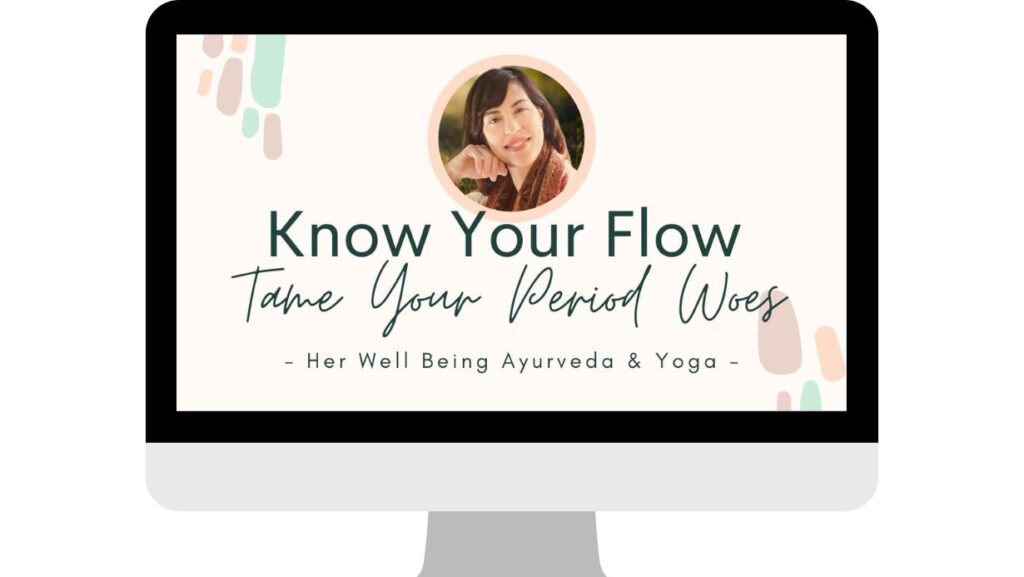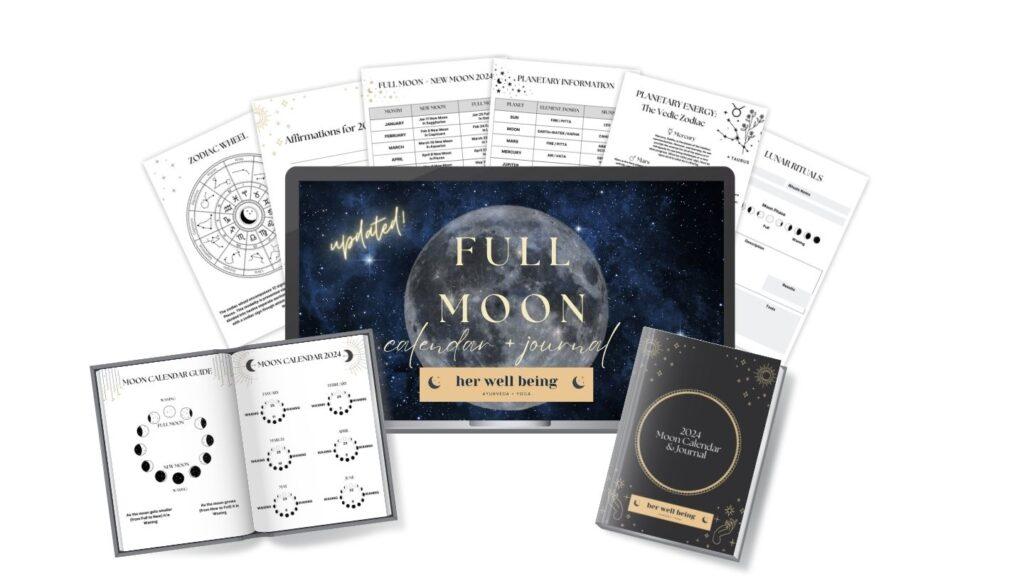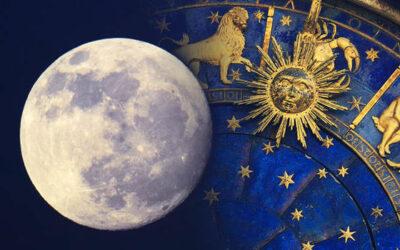Ayurvedic wisdom has been passed down through the generations that guide women in the many ways to enjoy a peaceful period and sustaining energy to get her through the whole monthly cycle . The many practices include using its traditional food as medicine approach, herbal allies, and self-care practices; however, the most important one, to begin with, is observing the moon cycles.
Know Your Flow Video Training: Discover a More Peaceful Period with Ayurveda
Unlock the secrets to embrace your menstrual cycle and be empowered to tame your period woes with help from Ayurveda. Discover the root cause of your period problems, menstrual type, and helpful foods that support wellbeing before and during your period.

How Do the Moon Cycles Support Woman’s Wellness?
Ayurveda has long supported that a woman’s health and well-being are associated with the Moon and that menstruation is associated with the moon’s phases. The Moon is considered the matriarch of the celestial world and is the embodiment of the Divine Feminine. She is imbibed with the energy of the Kapha dosha and has an abundance of both Earth and Water energy. She represents the mind and emotions for both men and women and represents fertility and creativity. Her energy is cooling, nurturing, and grounding. Observing the Moon and her phases is a foundational practice for women who want to receive lunar healing energy to support health and well-being in body, mind, and spirit.
It’s believed that the Full Moon is a time of fullness when the Moon’s energy is at its peak and so is that of a woman’s. This is traditionally considered an ideal time for ovulation. On the other side is the Dark or New Moon, also known as the Blood Moon, which is an ideal time for menstruation. The New Moon phase is when the Moon’s energy wanes; as a woman’s energy does. This is a time when a woman can focus on the internal process and connect with her feelings and emotions.
With the monthly menstrual cycle, women have a unique opportunity to attune to the energy of the phase of the moon for more support physically, mentally, and emotionally. These practices continue to be valuable well after menses has ended (menopause).
Full Moon Practices for Women
During the Full Moon (or Waxing Moon) Phase, which starts after the New Moon and the moon begins to grow again, a woman’s energy and vitality increase as does her metabolism. This prompts a hearty diet incorporating plenty of sustaining foods including whole grains, proteins of all kinds, eggs, and dairy along with a variety of plant foods. This phase corresponds with the growth of a follicle (egg) in the womb when estrogen dominates. She may feel more support to be more active and focus externally on work, service, relationships, etc. In general, this is a good time for action and expansive work, starting new projects, signing contracts, etc. Traditionally, the waxing moon phase is the best time to sow seeds, harvest crops, and perform rites of passage and spiritual rituals. It’s seen as auspicious to have the support of the growing moon.
The Full Moon is the apex of the cycle when a woman experiences the highest concentration of hormones at ovulation. Her energy and vitality are at their peak. This is a time of celebration and ritual to strengthen relationships, especially with other women. Women can gather to celebrate their fullness with song, dance, and pay homage to the Divine Feminine that supports all life on Earth and in the Universe.
Listen to the latest guided moon meditation with Heather on
Join the Full Moon meditation Group for Women
the Insight Timer app!
The New Moon (or waning moon) phase begins after the Full Moon when the Moon begins to disappear. This is not an auspicious time to start projects and do expansive work; rather, it’s a time for inner reflection, quietude, solitude, and self-care. Energy decreases. The hormone progesterone is dominant which causes fluid retention, slows down all internal processes including digestion and metabolism, and can affect emotions and mood. A supportive diet is easy to digest and simple. Think about nutritious soups, warm cereals, bone broths, steamed vegetables and greens, and light whole grains and lentils. Kitchari is an ideal food during menstruation because it’s nutritious and easy to digest. Reduce heavier foods like animal protein and dairy.
The New Moon when it is at its darkest point and disappears from the night sky marks the beginning of the new Lunar Cycle. Energy is at its lowest and women may feel the most vulnerable or sensitive. This is an ideal time for menstruation when women are encouraged to take time away from their usual obligations and take time for themselves. Our modern world and fast-paced lives seldom support this tradition; however, it is still possible for women to mark this time with reflection and rest.
Which is Right: Menstruating on the New or Full Moon?
Women may find that they typically menstruate with the New or the Full Moon. They may also find that their timing changes from time to time. There’s no right or wrong. Traditionally, menstruating with the New Moon can be more advantageous as its energy supports slowing down for self-care. This means your cycle is more influenced by female or lunar energy. If you are menstruating with the Full Moon, this may mean it is a time of great external efforts and that you will have two periods of rest during your cycle: once during the New Moon and again during menstruation. This means your cycle is informed by male or solar energy. If you switch gears to a more internal focus that harmonizes with feminine energy and focuses on reflection and self-care, you might find your menses starting closer to the New Moon.
Full Moon and Vedic Astrology
The Moon travels through a Zodiac sign every three days. The Full Moon can occur in a different astrological sign every month. This sign infuses the Full Moon with its energy whether it’s an air, fire, Earth, or water sign. Each Zodiac sign brings different doshas as well. Air signs will increase Vata, Fire signs will increase Pitta, and Earth and Water signs will increase Kapha. The constellation the Full Moon is visiting offers women a purpose and direction to channel their energy. A Virgo Full Moon may emphasize harmony and order whereas a Scorpio Full Moon may shine a spotlight on hidden emotions and secrets.
The Full Moon will also take place in a different nakshatra, or lunar mansion, which is ruled by a different planet. This brings its own energy to the lunar holiday, which is layered upon the theme of the dominating Zodiac sign. In fact, the Moon transits a different nakshatra for every day of the Lunar Cycle, which is 28 days. Every Full Moon will have a personal meaning for each individual as the Moon shows up differently in everyone’s natal chart.
There is a difference between Western and Vedic Astrology. The Vedic view of the heavens and celestial bodies is said to be more accurate as it is based on the laws of nature. Read on to learn more about that…
An essential difference between Western and Vedic, also known as Indian astrology, is the use of different zodiac systems. Western astrologers use the tropical zodiac, based upon the seasons and the orientation between the sun and Earth. In the tropical zodiac, the Spring Equinox always coincides with the onset of Aries season.
By contrast, Vedic astrology uses the sidereal zodiac which is based upon the physical positions of the constellations in the sky. As the Earth spins on its axis it experiences a bit of a tilt a whirl known as precession. As such the stars and constellations do not remain in a fixed state, in fact each star moves roughly one degree every 70 odd years.
While Western astrology does not take this shift into account, the sidereal system recognizes the discrepancy and corrects it within the birth chart using a system called ayanamas. For this reason, your sun sign in Vedic astrology may very well be different than what you have previously accepted.
https://nypost.com/article/what-is-vedic-astrology/
Your Guide to Moon Holidays & Wellness Rituals with Her Well Being’s Moon Calendar & Journal
The Full Moon holidays that land on your Zodiac sign will have more personal significance for you. You may feel these visiting energies more intensely, making self-reflection and self-care all the more important. Every Moon holiday brings a different theme to explore. Depending on the visiting zodiac sign and it’s ruling planet, you may experience some ups and downs. Need help keeping track?
Download the Moon Calendar & Journal to help you track lunar holidays and your own monthly cycle. Try time-honored self-care rituals for both the New and Full Moons for yourself, and journal about your experience.

Download the Moon Calendar & Journal (PDF Guide) to help you track lunar holidays, set your intentions, and connect with your heart and soul with self-care rituals passed down through generations of women.
sign up for the Moon calendar here
Balance Your Cycle with Ayurvedic Monthly Practices
To start, you can begin to track when the Full and New Moon Events are on your calendar. Then, start tracking your menses if you’re not already. Do this manually on a printed calendar and put it in a place you see every day. Take note of when you’re menstruating and any patterns before, during, and after. Include symptoms, emotions, and any self-care practices you do. You can also do this in a dedicated moon journal ( or download ours!). Track how you feel physically, mentally, and emotionally. Forecast when you expect your next period so you can anticipate and prepare for it.
If you’re menstruating with the Full Moon, use more self-care measures and take more time for yourself that help you to connect with your feelings and your needs (physical, mental, and emotional), and opt out of nonessential activities so you can get more rest. Do these practices again when the New Moon comes. Track your progress and how you feel in your moon journal.
Prevention is the best medicine when it comes to preparing for menopause. Don’t just wait for it to happen to you. Be proactive now and take the reigns of your cycle so that when it comes to an end you don’t have such a hard time like many women do.
Remember that it takes time to put these practices in place and that patience and self-compassion are your best allies. Return to the Guide time and time again for guidance and inspiration on your lunar cycle journey.
Make The Most of Lunar Holidays at The Women’s Full Moon Circle
The Full Moon is a time for women to gather and support each other. A time for self-expression and channeling the full energy of the Moon for meaningful personal and universal purposes. The invitation is to sync with the rhythm of the lunar cycle, a women’s tradition as old as time, as a way to be in tune with nature and the intuitive powers of the divine Feminine.
Through meditation, journaling, and sharing connect with this universal wisdom to guide us on our path toward personal growth, spirituality, and enlightenment. Every month is a different theme that takes us further on the soul’s journey. The highlighted zodiac sign is associated with a planet that brings its own personality and deep inquiries for us to explore. Won’t you join us?
Monthly Astrology & Upcoming Events on Her Well Being’s Astrology Blog Page
Check out my astrology blog page below for upcoming Full Moon events whether they’re in person or online. I hope you’ll join me! Check back every month for monthly astrological updates and self-care rituals that support the energy of the New and Full Moons.


Heather R. Burkart
Certified Ayurvedic Practitioner
Founder, Her Well Being Ayurveda & Yoga
Please be advised that the content on this website is for education and information purposes only and does not replace advice from a medical professional.





0 Comments
Trackbacks/Pingbacks